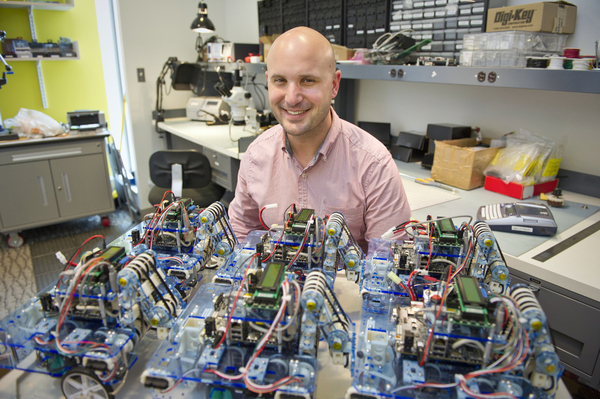3Qs: Controlling a robot from another planet

Prior to joining the Northeastern faculty as an assistant professor in the College of Computer and Information Science, Marsette Vona worked for NASA’s Jet Propulsion Laboratory as part of the teams that put both the Spirit and Opportunity rovers on the surface of Mars. We asked Vona, who is developing robots that can detect uncertainty in their environment, to explain how Curiosity, the newest and most advanced rover on the red planet, and its crew on Earth handle the logistical challenges of space exploration.
The vast distance between Earth and Mars makes it impossible for NASA scientists to communicate or control Curiosity without a time delay. To compensate for this time delay, what did engineers and programmers need to consider when designing the rover and planning the mission?
The Earth to Mars radio delay, which ranges from about three to 20 minutes, adds significant complexity to robotic missions on Mars. Another challenge is the logistics of scheduling the Deep Space Network radio dishes, which are shared with other distant space missions and which are our only means to communicate at interplanetary distances. Yet another issue is that each Mars day is about 40 minutes longer than an Earth day, making it difficult to synchronize human operators living on Earth time with rover activity in daylight on Mars.
So in order to get much done, the robots we send to Mars must be fairly intelligent: They must be able to operate autonomously for some amount of time. We cannot “remote control” them as we can do, for example, with sub-sea exploration robots on Earth. Instead, we typically send them commands before dawn on each Martian day. They execute those commands autonomously, possibly making some decisions on their own, and radio back results and status information during the following Martian night.
Your expertise lies in understanding how robots handle uncertainty, such as uneven terrain or unexpected surroundings. How does Curiosity handle similar challenges and how can those technical advances be used on Earth?
Curiosity uses a combination of techniques to reliably move around in the sand and rock environment of the Martian surface. First, its mobility system, composed of six wheels and a suspension called a rocker-bogey, enable it to roll right over rocks up to 50 centimeters (about 20 inches) tall. Second, it will automatically attempt to drive around larger obstacles, which it looks for using computer vision algorithms in live video feeds from front- and rear-facing cameras called “hazcams.” Third, it can use other computer vision algorithms to analyze longer-distance images from mast-mounted “navcams” for several purposes, including “visual odometry” to estimate how far it has actually traveled (which may differ from wheel rotation data because of slippage in the sand), and target tracking to monitor progress toward a visible goal such as an interesting rock.
A mobility system like that on Curiosity could be used on Earth for robots that must travel over rubble after, say, an earthquake or other disaster. Its computer vision algorithms for autonomous navigation and obstacle avoidance are also extremely useful; related systems are used on Earth for autonomous cars. Some of my own current research focuses on adapting algorithms like this for walking robots, which could help humans travel over very uneven ground, or which could eventually replace us in undertaking hazardous tasks.
How is Curiosity’s ability to explore Mars different from the Spirit and Opportunity rovers?
Over the last 15 years we have successfully landed four rovers on Mars. New technologies successfully tested in each mission are incorporated into later ones. Also, each mission has approximately doubled the rover size, which is important because larger rovers can carry more scientific instruments and can travel farther and faster.
Spirit and Opportunity tested precursors to the automatic navigation, obstacle avoidance and visual odometry algorithms on Curiosity. Curiosity, however, is twice their size (about 3 meters long) and has additional autonomous navigation capabilities that should enable it to travel farther on its own. Curiosity also used a new “sky crane” landing system instead of airbags, and it is powered by a radioisotope thermal generator, unlike Sojourner, Spirit, and Opportunity, which were solar powered. This should enable it to operate over a full Martian year, whereas the previous missions were typically only active in the plentiful sunlight of the Martian summer. Finally, and possibly most significantly, Curiosity carries several new instruments that will be used to analyze samples of the Martian rock to detect water, carbon compounds and other biologically important materials. This will both help us understand whether life ever existed on Mars and also the extent to which we will be able to use materials on Mars to help support future human explorers.